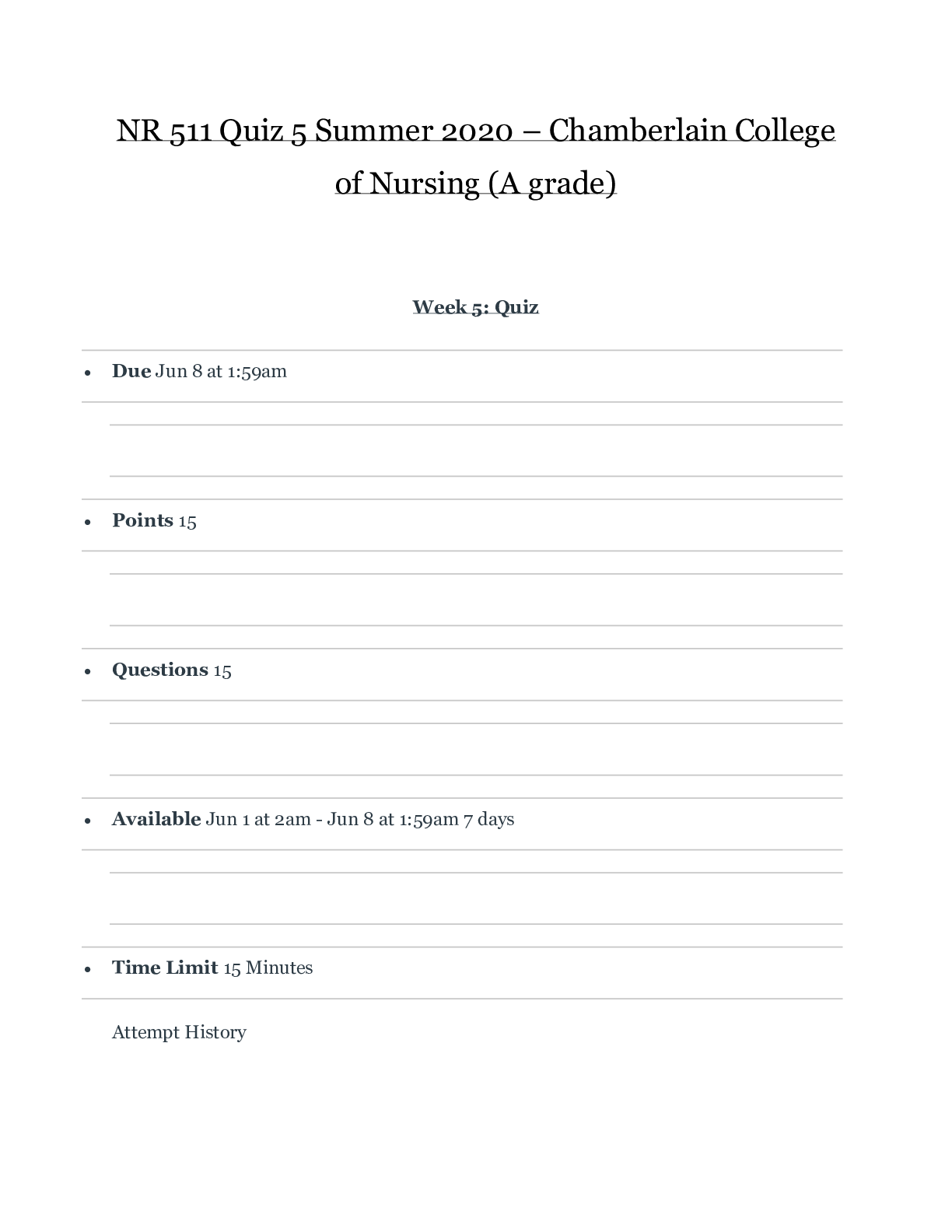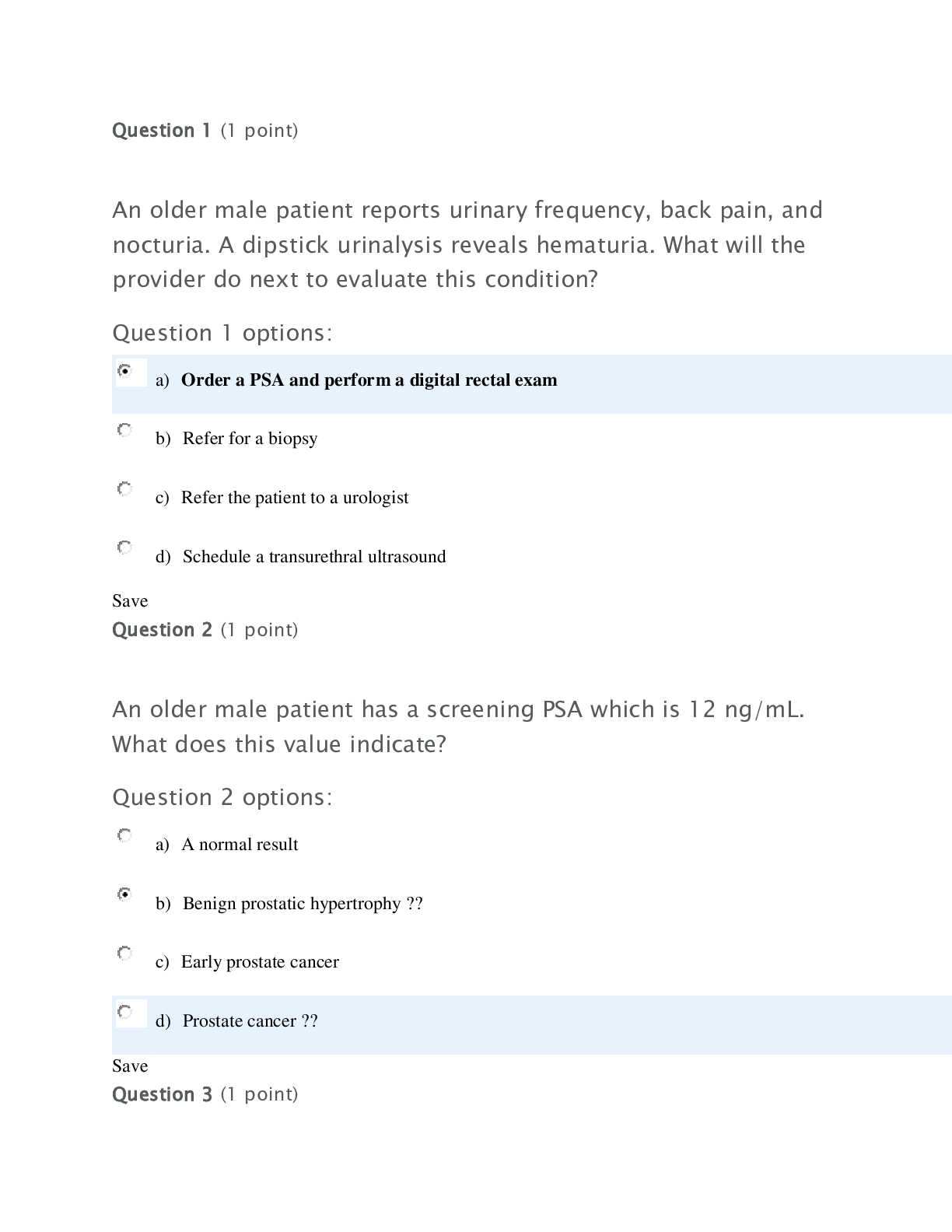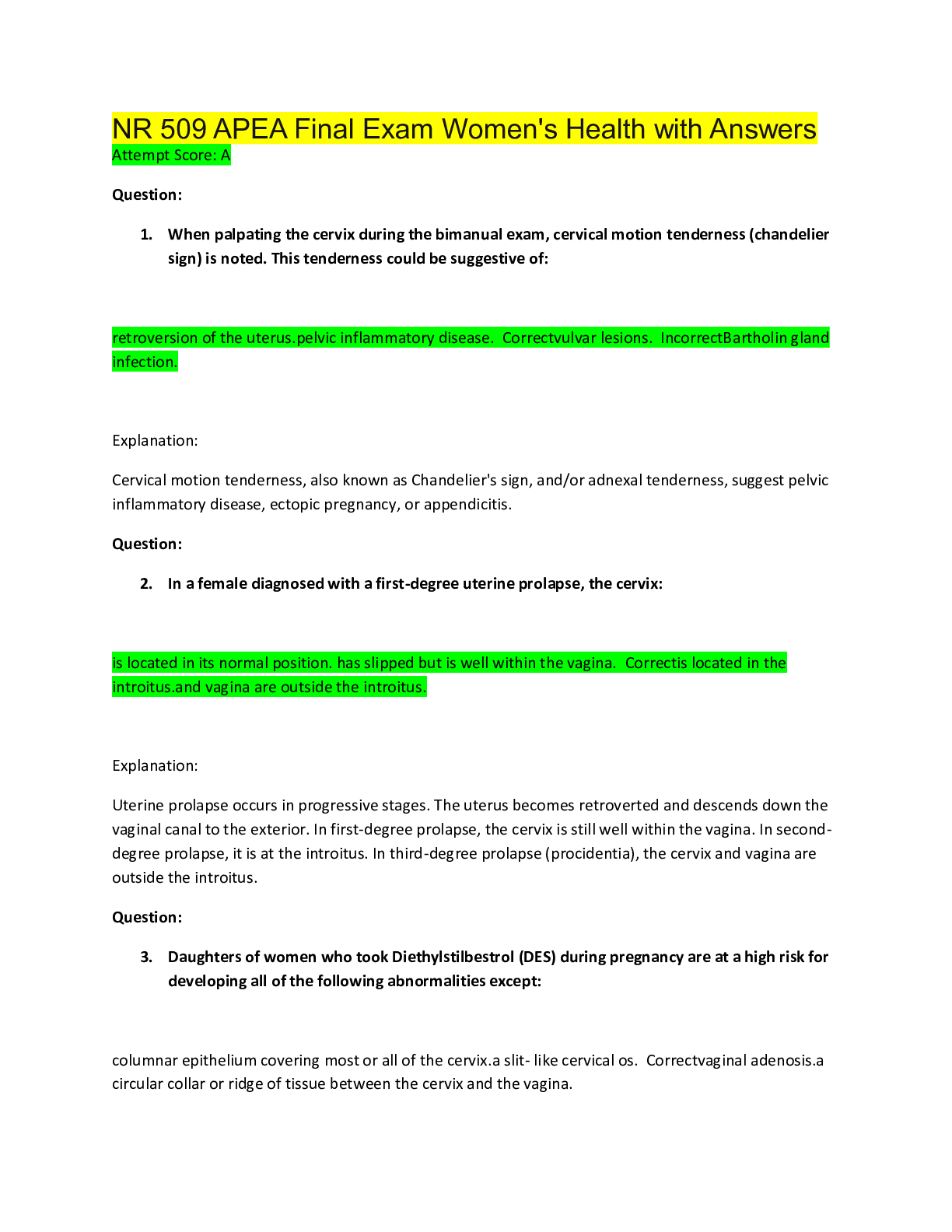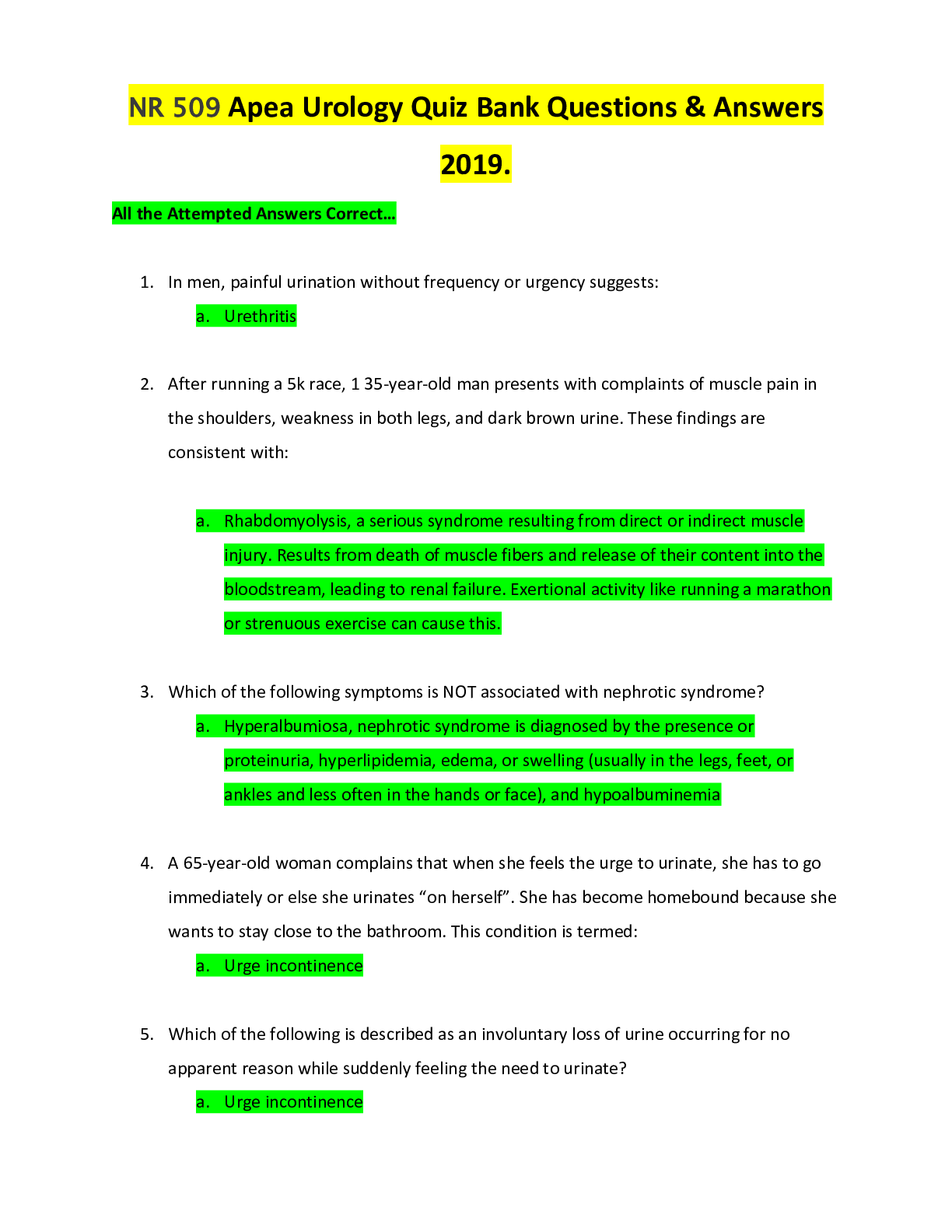*NURSING > EXAM > NR 511 Quiz 5 Summer 2020 – Chamberlain College of Nursing (A grade) | NR511 Quiz 5 Summer 2020 � (All)
NR 511 Quiz 5 Summer 2020 – Chamberlain College of Nursing (A grade) | NR511 Quiz 5 Summer 2020 – (A grade)
Document Content and Description Below
NR 511 Quiz 5 Summer 2020 – Chamberlain College of Nursing (A grade) Week 5: Quiz • Due Jun 8 at 1:59am • Points 15 • Questions 15 • Available Jun 1 at 2am - Jun 8 at ... 1:59am 7 days • Time Limit 15 Minutes Attempt History Attempt Time Score LATEST Attempt 1 10 minutes 15 out of 15 Score for this quiz: 15 out of 15 Submitted Jun 5 at 4:54pm This attempt took 10 minutes. Question 1 1 / 1 pts A 42-year-old professional golfer complains of chronic back pain for many years. His workup reveals that it is not the result of a degenerative disc problem. His back “goes out” about twice per year, and he is out of work for about a week each time. Which of the following should the clinician advise? Consider changing careers to something less physical. Start on a daily low-dose narcotic to take away the pain. Make an appointment with a neurosurgeon for a surgical consultation. Correct! Begin a planned exercise program to strengthen back muscles. In this case, the patient may benefit from a regular planned exercise program to strengthen his back muscles and attempt to reduce the probability of future episodes of back pain. Question 2 1 / 1 pts A 49-year-old female presents with low back pain radiating into the right leg,. An x-ray of the lumbosacral spine is within normal limits. Which of the following diagnoses do you explore further? Compression fracture. Correct! Herniated nucleus pulposus. Scoliosis. Osteoarthritis. A plain x-ray will not show a herniated nucleus pulposus or a muscle strain. It will show spondylolisthesis, scoliosis, osteoarthritis, and spinal stenosis. Note that x-rays of the spine are not indicated in low back pain unless the cause of the pain is thought to be bony in origin or traumatic in nature or there is a need to rule out systemic disease. Question 3 1 / 1 pts In assessing the skeletal muscles, the clinician turns the patient’s forearm so that the palm is face up. This is called: Pronation. Correct! Supination. Abduction. Eversion. Turning the forearm so that the palm is up is called supination. Question 4 1 / 1 pts A conservative approach is recommended in the initial approach to the management of low back pain. Which of the following would be an appropriate treatment plan for a 32-year-old obese male (BMI 33) diagnosed with an acute lumbar strain? Bedrest. Correct! Non-Steroidal Anti-Inflammatory Drugs (NSAIDs). Epidural Steroid Injections (ESI). Surgery. It has been proven that rest has little to no effect on the resolution of LBP. Patients should do whatever activities are tolerable. Almost 90% of cases resolve within 1 to 6 weeks thus the initial management should include non-pharmacologic (masage, heat, etc.), pharmacological (NSAIDs, short term use of muscle relaxants) and activity. Surgery and ESI are not indicated in the initial management of LBP. Question 5 1 / 1 pts A 13-year-old obese (body mass index [BMI] above the 95th percentile) boy reports low-grade left knee pain for the past 2 months. He denies antecedent trauma but admits to frequent “horseplay” with his friends. The pain has progressively worsened, and he is now unable to bear weight at all on his left leg. His current complaints include left groin, thigh, and medial knee pain and tenderness. His examination demonstrates negative drawer, Lachman, and McMurray tests; left hip with decreased internal rotation and abduction; and external hip rotation with knee flexion. Based on the above scenario, the clinician should suspect which of the following? A left meniscal tear. Osgood-Schlatter disease. A left anterior cruciate ligament (ACL) tear. Correct! A slipped capital femoral epiphysis (SCFE). SCFE is a displacement of the femoral head relative to the femoral neck that occurs through the physis (growth plate) of the femur. The vast majority of clients with this condition are obese, as the added weight increases shear stress across the physis. The mean age at diagnosis is 12 years for females and 13.5 years for males. Surgery is often required via in situ pin fixation (single screw) to stabilize the growth plate to prevent further slippage and avoid complications. Question 6 1 / 1 pts A 55-year-old patient is able to complete range of motion (ROM) against gravity with some resistance. The nurse practitioner would assign which of the following numerical grades to this manual muscle testing description? 2 3 Correct! 4 5 Normal muscle strength and function and complete ROM against gravity with full or normal resistance would be given a numerical grade of 5. Complete ROM against gravity with some resistance is given a numerical grade of 4 and described as good muscle strength. Complete ROM against gravity is indicative of fair muscle strength and function and is given a numerical grade of 3. A grade of 2, denoting poor muscle strength, is given for complete ROM with gravity eliminated. Question 7 1 / 1 pts A 16-year-old male patient presents to the clinic after sustaining a football injury to his right knee. The clinician elicits a positive anterior/posterior drawer sign. This test indicates an injury to the ______? Lateral meniscus. Medial meniscus. Correct! Cruciate ligament. Collateral ligament. Positive anterior and posterior drawer signs indicate injury to the anterior cruciate ligament and posterior cruciate ligament, respectively. The drawer and Lachman tests are utilized to assess for cruciate ligament injury. Question 8 1 / 1 pts A 28-year-old male presents to the clinic for follow-up from the emergency department, where he was seen for right forearm pain 3 days ago. He works as a carpenter and is right hand dominant. He states he was diagnosed with right forearm tendinitis and is not sure what this means. As part of teaching, the clinician explains that the condition is caused by inflammation of one or more of the tendons. Which of the following describes tendons? The fibrocartilaginous disks that separate bony surfaces. The pouches of synovial fluid that cushion bone and other joint structures. Correct! The collagen fibers that connect muscle to bone. The ropelike bundles of collagen fibrils that connect bone to bone. Tendons are the collagen fibers that connect muscle to bone. Question 9 1 / 1 pts A 10-year-old male presents to the clinic after jumping off a 2-foot wall, twisting his foot and ankle upon landing. His ankle x-ray demonstrates a fracture of the distal tibia, over the articular surface, through the epiphysis and physis. Based on the Salter-Harris classification of growth plate injuries, the clinician knows that this is a ______? Salter-Harris V fracture. Salter-Harris IV fracture. Correct! Salter-Harris III fracture. Salter-Harris II fracture. The Salter-Harris classification system of growth plate injuries divides most growth plate injuries into 5 categories based on the damage: A Salter-Harris I fracture travels through the physis. A Salter-Harris II fracture travels through the metaphysis and physis. A Salter-Harris III fracture travels through the epiphysis and physis. A Salter-Harris IV fracture travels through the metaphysis, epiphysis, and physis. A Salter-Harris V fracture involves a compression injury of the physis. Question 10 1 / 1 pts A 62-year-old woman presents to the clinic with chronic low back pain. She states she has developed episodes of fecal incontinence and numbness in her right leg over the last week. Upon examination the clinician notes decreased perianal sensation to pinprick. What should the clinician do next? Order a MRI. Prescribe physical therapy for 6 weeks. Correct! Refer the patient to the Emergency Room (ER). Send the patient for Electromyelography (EMG) testing. Cauda equina is characterized by loss of bowel/bladder control or saddle-pattern anesthesia (perineum). If left untreated, compression can cause ischemia and permanent nerve damage leading to incontinence and paralysis. The patient should be immediately referred to the ER. Question 11 1 / 1 pts The valgus stress test, varus stress test, Lachman test, and thumb sign are all considered standard tests to check the integrity of the ligaments of the knee. Which of the following would the clinician choose to assess the anterior cruciate ligament (ACL), which is the most commonly involved structure in severe knee injury? Thumb sign. Valgus stress test. Varus stress test. Correct! Lachman test. The Lachman test assesses the ACL. Question 12 1 / 1 pts A 55-year-old female patient presents with complaints of pain and paresthesias in the left ulnar aspect of the forearm, thumb, and middle finger following a C6 & C7 nerve root dermatomal pattern. This is known as ________? Correct! Cervical radiculopathy. Thoracic outlet syndrome. Brachial plexus neuritis. Peripheral polyneuropathy. Cervical nerve root compression of C6 and C7 causes cervical radiculopathy. Brachial plexus neuritis presents with dysfunction ranging from momentary paresthesias to completely flail extremities and is usually caused by injuries to the C5 and C6 nerve roots. Peripheral polyneuropathy is associated with distal sensorimotor paresthesia and diminished deep tendon reflexes. Thoracic outlet syndrome is caused by compression of the brachial plexus and/or subclavian vessels as they exit the space between the superior shoulder girdle and the first rib. Symptoms are color changes in the hand and sensory changes and weakness in the fourth and fifth fingers. Question 13 1 / 1 pts A 55-year-old female presents to the clinic with complaints of left hand and wrist pain and swelling after a slip and fall on the ice yesterday. On examination, the clinician notes tenderness at the “anatomical snuffbox.” This finding most likely indicates which of the following? Hamate fracture. Ulnar styloid fracture. Correct! Scaphoid fracture. Radial head fracture. There is tenderness over the “anatomical snuffbox” in a scaphoid (aka navicular) fracture, the most common injury of the carpal bones. Poor blood supply puts the scaphoid bone at risk of avascular necrosis; therefore, wrist pain and tenderness in the anatomical snuffbox, even without history of antecedent trauma, warrant a wrist x-ray. Question 14 1 / 1 pts A 48-year-old male presents with acute low back pain in the right that increases when standing and bending. Upon physical exam, lower extremity muscle strength is 5/5 and straigh leg raise test is negative. Which of the following is the most likely diagnosis? Osteoarthritis. Spondylolisthesis. Correct! Muscle strain. Herniated nucleus pulposus. Muscle strain is usually located in the low back and is unilateral in location. The onset is acute, and pain increases with standing and bending and decreases with sitting. The straight leg raise test and plain x-ray are both negative. Question 15 1 / 1 pts A 16-year-old boy presents to the office with complaints of low back pain after lifting heavy boxes. In discussing with him proper body mechanics to prevent future injuries, the clinician should advise which of the following? Correct! “Bend your knees and face the object straight on.” “Bend and twist simultaneously as you lift.” “Keep your feet firmly together.” “Hold boxes away from your body at arm’s length.” In discussing with the patient proper body mechanics to prevent future injuries, you tell him to bend his knees and face the object straight on, to hold boxes close to his body and not at arm’s length, and to spread his feet about shoulder width apart. Using legs and arms, facing objects straight on, and keeping a wide stance will provide a broad base of support and allow for use of supporting muscles, relieving stress on the back muscles. Quiz Score: 15 out of 15 PreviousNext Submission Details: [Show More]
Last updated: 1 year ago
Preview 1 out of 15 pages

Buy this document to get the full access instantly
Instant Download Access after purchase
Add to cartInstant download
We Accept:

Reviews( 0 )
$12.50
Document information
Connected school, study & course
About the document
Uploaded On
Jul 01, 2020
Number of pages
15
Written in
Additional information
This document has been written for:
Uploaded
Jul 01, 2020
Downloads
0
Views
54






















